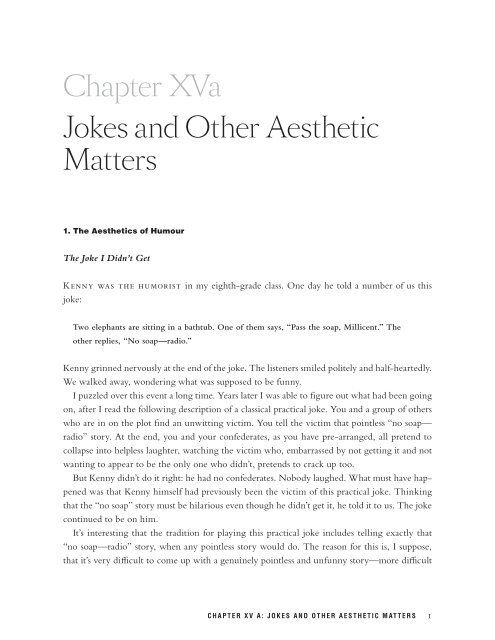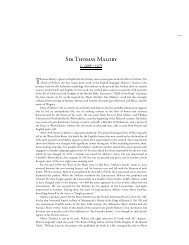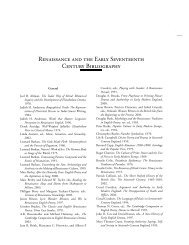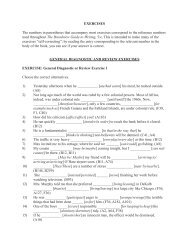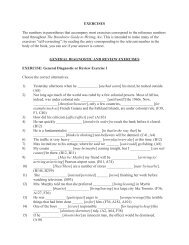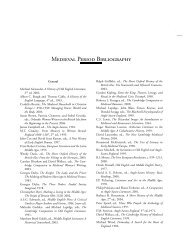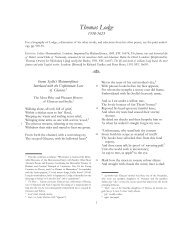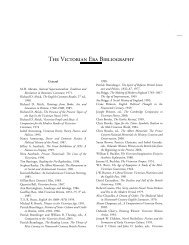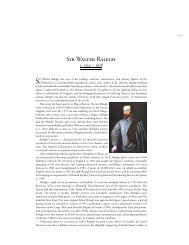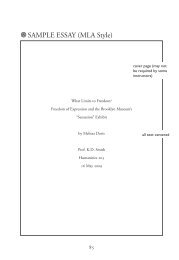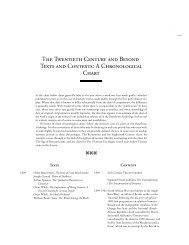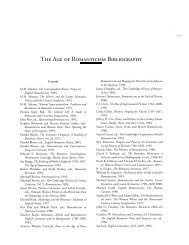Chapter XVa Jokes and Other Aesthetic Matters - Broadview Press ...
Chapter XVa Jokes and Other Aesthetic Matters - Broadview Press ...
Chapter XVa Jokes and Other Aesthetic Matters - Broadview Press ...
You also want an ePaper? Increase the reach of your titles
YUMPU automatically turns print PDFs into web optimized ePapers that Google loves.
<strong>Chapter</strong> <strong>XVa</strong><br />
<strong>Jokes</strong> <strong>and</strong> <strong>Other</strong> <strong>Aesthetic</strong><br />
<strong>Matters</strong><br />
1. The <strong>Aesthetic</strong>s of Humour<br />
The Joke I Didn’t Get<br />
Kenny was the humorist in my eighth-grade class. One day he told a number of us this<br />
joke:<br />
Two elephants are sitting in a bathtub. One of them says, “Pass the soap, Millicent.” The<br />
other replies, “No soap—radio.”<br />
Kenny grinned nervously at the end of the joke. The listeners smiled politely <strong>and</strong> half-heartedly.<br />
We walked away, wondering what was supposed to be funny.<br />
I puzzled over this event a long time. Years later I was able to figure out what had been going<br />
on, after I read the following description of a classical practical joke. You <strong>and</strong> a group of others<br />
who are in on the plot find an unwitting victim. You tell the victim that pointless “no soap—<br />
radio” story. At the end, you <strong>and</strong> your confederates, as you have pre-arranged, all pretend to<br />
collapse into helpless laughter, watching the victim who, embarrassed by not getting it <strong>and</strong> not<br />
wanting to appear to be the only one who didn’t, pretends to crack up too.<br />
But Kenny didn’t do it right: he had no confederates. Nobody laughed. What must have happened<br />
was that Kenny himself had previously been the victim of this practical joke. Thinking<br />
that the “no soap” story must be hilarious even though he didn’t get it, he told it to us. The joke<br />
continued to be on him.<br />
It’s interesting that the tradition for playing this practical joke includes telling exactly that<br />
“no soap—radio” story, when any pointless story would do. The reason for this is, I suppose,<br />
that it’s very difficult to come up with a genuinely pointless <strong>and</strong> unfunny story—more difficult<br />
chapTer xv a: JoKes <strong>and</strong> oTher aesTheTic maTTers 1
than thinking up a funny one. The “no soap—radio” story is actually a very artful <strong>and</strong> clever<br />
creation: it’s a story with all the form <strong>and</strong> rhythm of a joke, but utterly lacking the funny content.<br />
Whether or not you approve of practical joking, you have to admire the skill involved in<br />
the creation of this one.<br />
Two questions are suggested here. One is this: what, really, is joke form? Everyone who has<br />
heard jokes told badly knows that, to be funny, jokes need to have exactly the right structure<br />
<strong>and</strong> need to be told exactly right. This one has the form exactly right, <strong>and</strong> Kenny was a master<br />
of joke execution. But form <strong>and</strong> execution aren’t sufficient to make something funny. The<br />
second, <strong>and</strong> more difficult question, is this: why is some content funny?<br />
Prison Humour<br />
Here’s a joke about jokes that illustrates these questions.<br />
A man is spending the first day of his sentence in prison. He is at lunch in the huge prison<br />
dining hall; all the inmates are quietly eating. Suddenly one inmate shouts out, “Sixty-three!”<br />
<strong>and</strong> everyone laughs. A few minutes later, another inmate yells, “Three hundred <strong>and</strong> four!”<br />
<strong>and</strong> everyone laughs again.<br />
The new arrival is puzzled. “What’s going on?” he asks the man sitting next to him.<br />
His neighbour replies: “We’ve all been together so long that we’ve heard each other’s jokes<br />
over <strong>and</strong> over again, <strong>and</strong> we have all the jokes memorized. To save effort, we’ve given each<br />
joke a number, so all we have to do to tell one of these jokes is to give its number.”<br />
“Hey, that’s a good idea,” says the new arrival. “I think I’ll try telling one.” He shouts,<br />
“Ninety-seven!” Silence. Nobody even smiles. “What did I do wrong?” he asks his neighbour.<br />
The neighbour replies, “Well, some people just don’t know how to tell a joke.”<br />
There is, by the way, an entire genre of jokes about jokes. (They’re sometimes called metajokes.)<br />
Here are some more:<br />
A passenger in a train was watching the puzzling behaviour of the old man across the aisle:<br />
he’d mumble a few words to himself, then smile, then raise his h<strong>and</strong> <strong>and</strong> stop talking; then<br />
repeat the sequence, then do it again, over <strong>and</strong> over, for an hour.<br />
Finally the passenger became overcome with curiosity, <strong>and</strong> went across the aisle. “Excuse<br />
me,” he said, “but I couldn’t help noticing what you were doing. Is something wrong?”<br />
chapTer xv a: JoKes <strong>and</strong> oTher aesTheTic maTTers 2
The old man replied, “No, everything’s fine. When I take a long train trip I tell myself<br />
jokes to keep myself from getting bored, <strong>and</strong> that’s why I was smiling.”<br />
“But why did you keep raising your arm?”<br />
“That’s to interrupt myself because I’ve already heard that joke.”<br />
A clown, a nun, <strong>and</strong> a duck walk into a bar. The bartender says, “What is this? Some sort<br />
of a joke?”<br />
This last one is a lawyer meta-joke. It’s from a speech given at a law school by Chief Justice of<br />
the US Supreme Court William Rehnquist:<br />
I’ve often started off with a lawyer joke, a complete caricature of a lawyer who’s been nasty,<br />
greedy <strong>and</strong> unethical. But I’ve stopped that practice. I gradually realized that the lawyers in<br />
the audience didn’t think the jokes were funny <strong>and</strong> the non-lawyers didn’t know they were<br />
jokes.1<br />
Laughter Is the Best Medicine<br />
“Humor can be dissected as a frog can, but the thing dies in the process <strong>and</strong> the innards are<br />
discouraging to any but the pure scientific mind.”—E.B. White2<br />
White speaks the truth. But when there’s something to analyze, you can’t stop philosophers<br />
from trying.<br />
Immanuel Kant is among the most ponderous of philosophical writers, but even his writing<br />
contains a few jokes (presented in connection with his theorizing on humour). This is one:<br />
The heir of a rich relative wants to arrange for him a very solemn funeral service, but com-<br />
plains that things are not quite working out: for (he says) the more money I give my mourners<br />
to look grieved, the more cheerful they look.<br />
Another Kantian joke is the story of<br />
the grief of some merchant who, during his return trip from India to Europe, with all<br />
his fortune in merch<strong>and</strong>ise, was forced by a heavy storm to throw everything overboard,<br />
1 Quoted in Marc Galanter, Lowering the Bar: Lawyer <strong>Jokes</strong> <strong>and</strong> Legal Culture (Madison: University of Wisconsin <strong>Press</strong>, 2006).<br />
2 Quoted in Robert Byrne, 1,911 Best Things Anybody Ever Said (New York: Fawcett Columbine, 1988), p. 383.<br />
chapTer xv a: JoKes <strong>and</strong> oTher aesTheTic maTTers 3
<strong>and</strong> whose grief was such that it made his wig turn grey that very night. [Kant’s—or his<br />
translator’s—italics]<br />
Kant remarks that the second joke “will make us laugh,” <strong>and</strong> that the first “evokes ringing<br />
laughter in us.” Whenever you read philosophy, you must ask yourself whether what the philosopher<br />
says is true.<br />
Kant theorizes that “Laughter is an affect that arises if a tense expectation is transformed into<br />
nothing.” He gives a physiological explanation of how laughter results, <strong>and</strong> consequently of<br />
why we enjoy humour:<br />
For if we assume that all our thoughts are, in addition, in a harmonious connection with some<br />
agitation in the body’s organs, then we can pretty well grasp how, as the mind suddenly shifts<br />
alternately from one position to another in order to contemplate its object, there might be a<br />
corresponding alternating tension <strong>and</strong> relaxation of the elastic parts of our intestines that is<br />
communicated to the diaphragm.... The lungs, meanwhile, rapidly <strong>and</strong> intermittently expel<br />
air, <strong>and</strong> so give rise to an agitation that is conducive to our health. It is this agitation alone,<br />
<strong>and</strong> not what goes on in the mind, that is the actual cause of our gratification in a thought<br />
[by] which [we] basically present nothing.1<br />
The well-known American psychologist Michael Gassaniga relays this hypothesis about Kant:<br />
“... a young French doctor ... wanted to talk about Immanuel Kant’s brain lesion. His what?<br />
Dr. Jean-Christophe March<strong>and</strong> had been reading about Kant’s life <strong>and</strong> medical history.<br />
Until Kant reached the age of forty-seven or so, his writings were straight-forward <strong>and</strong>,<br />
believe it or not, clear. After this age, Kant began to write his great philosophical works,<br />
which emphasize that innate cognitive structures exist independent of emotions. Nearly im-<br />
possible to read, his works make Jean Piaget’s ‘writing’ seem lucid. But March<strong>and</strong>’s points<br />
are tantalizing. Kant began to complain of headaches <strong>and</strong> other maladies <strong>and</strong> gradually lost<br />
vision in his left eye. Dr. March<strong>and</strong> deduced that Kant had a left prefrontal lobe tumor—<br />
growing slowly but there. Damage to this area affects language ability <strong>and</strong> the ability of<br />
our emotional system to cue us toward good cognitive strategies. Is it possible that all those<br />
Kantians have saluted a man who was writing nonsense—a philosophy for those who do<br />
not have a normal cognitive <strong>and</strong> emotional system?”2<br />
1 Immanuel Kant, Kritik der Urteilskraft, §54. Translated as Critique of Judgement by Werner S. Pluhar (Indianapolis: Hackett<br />
Publishing Company, 1987).<br />
2 The Mind’s Past (Berkeley: University of California <strong>Press</strong>, 1998), p. 120.<br />
chapTer xv a: JoKes <strong>and</strong> oTher aesTheTic maTTers 4
The great American humorist Robert Benchley may have been aware of this low-point in<br />
Kant’s philosophical writing when he inserted this footnote in his parody of an academic<br />
analysis of humor: “Schwantzleben, in his work Humor After Death, ... says ‘All laughter is a<br />
muscular rigidity spasmodically relieved by involuntary twitching. It can be induced by the<br />
application of electricity as well as by a so-called “joke.”’”1<br />
(Benchley is quoted as remarking, “Defining <strong>and</strong> analyzing humor is a pastime of humor-<br />
less people.”)<br />
Kant is not the only one with theories about what makes something funny. A 1990 issue of<br />
The Realist carries a report of a conference on popular culture at which a paper was given<br />
titled “The Illusion of Ontotheological Reality in the Three Stooges.” According to this<br />
article, none of the Stooges graduated from high school; but Moe’s daughter, who spoke at<br />
the conference, reported that her father frequently expressed his concern about the ensemble’s<br />
ability to create the illusion of ontotheological reality.2<br />
(No, I don’t know what “ontotheological reality” means either.)<br />
Not Funny<br />
Here’s a Jewish joke, in the form of a riddle.<br />
Q: Who are the three cowboys in Adon Olam?<br />
A: Billy Reysheet, Billy Tachleet, <strong>and</strong> Kid Ruchi.<br />
Ha ha! Cowboys! Get it? Neither did I. I picked this joke precisely because in order to get<br />
it you’d have to have some fairly specialized knowledge. You’d need to be familiar with the<br />
Jewish hymn “Adon Olam.” The Hebrew words of the hymn mean<br />
Master of the World who was king,<br />
before any form was created.<br />
At the time when He made all through His will,<br />
then His name was called ‘King.’<br />
And after all is gone,<br />
He, the Awesome One, will reign alone.<br />
1 “Why We Laugh—or Do We?” in The New Yorker, 1937; reprinted in The Benchley Roundup (New York: Harper & Brothers,<br />
1983).<br />
2 Robert Myers, “Pop Goes the Culture!” The Realist No. 113 (Summer 1990): 5–6. .<br />
chapTer xv a: JoKes <strong>and</strong> oTher aesTheTic maTTers 5
And He was, <strong>and</strong> He is,<br />
<strong>and</strong> He will be in splendor ...<br />
<strong>and</strong> so on—nothing whatever to do with cowboys. The joke depends on the fact that the<br />
Hebrew words include these phrases:<br />
be-li rei-shit<br />
be-li tach-lit<br />
kid ru-chi<br />
which more or less sound like names in English beginning with “Billy” or “Kid,” which are<br />
imagined to be cowboy names. So the joke depends on puns on those Hebrew phrases, together,<br />
I expect, with the massive incongruity of associating cowboys with the text of this hymn.<br />
Whew! There’s the whole explanation! Now do you think the joke is funny?<br />
No.<br />
Neither do I. I suspect that the joke is not exactly fabulously hilarious anyway, even to people<br />
who know all about the Hebrew hymn. But whatever small humour is in it is certainly killed<br />
when it’s given a tedious explanation after having been told.<br />
So two facts about the humour of jokes have been illustrated here: (1) Getting some jokes depends<br />
on the hearer’s having background knowledge. (2) Providing the background knowledge<br />
after telling the joke does not convert it into something funny.<br />
In his wonderful book <strong>Jokes</strong>: Philosophical Thoughts on Joking <strong>Matters</strong>,1 Ted Cohen argues that<br />
a major function of humour is to establish a communal bond between the teller <strong>and</strong> the tellee:<br />
they both have the specialized background knowledge already.<br />
A Joke for Babies<br />
Notwithst<strong>and</strong>ing all this, it’s clear that there is some humour that doesn’t depend<br />
on specialized background knowledge. Consider the case of Anna’s giggles. Anna Martin is a<br />
gr<strong>and</strong>daughter of mine, so she is, of course, exceedingly intelligent <strong>and</strong> precocious, but for the<br />
first few months of her life, her specialized knowledge of things wasn’t exactly encyclopedic.<br />
Were she able to talk then, she would need only two words to express her reactions to the<br />
1 Chicago: University of Chicago <strong>Press</strong>, 1999.<br />
chapTer xv a: JoKes <strong>and</strong> oTher aesTheTic maTTers 6
external world: “Huh??” <strong>and</strong> “Food!!” But at ten weeks, she started laughing at things. The<br />
joke most reliably able to crack her up was when her mother opened her eyes wide <strong>and</strong> made<br />
kissy noises. (Just try to explain to me what’s funny about that.)<br />
The incredibly early arrival—before almost every other complicated capacity—of a sense of<br />
humour in babies appears to show just how basic it is to us humans.<br />
The Koestler/Pinker Theory of <strong>Jokes</strong><br />
The best account of The Funny I’ve seen is due to the writer Arthur Koestler, as reported<br />
<strong>and</strong> refined by the psychologist Steven Pinker.1 According to the Koestler/Pinker theory, there<br />
are three ingredients of humour: anomaly, resolution, <strong>and</strong> indignity. The anomaly is a matter of<br />
bumping one train of thought against an event or statement that makes no sense in the context<br />
of what came before. The resolution of this anomaly occurs when one shifts to a different frame<br />
of reference in which this does make sense. And within that new frame, someone’s dignity has<br />
been downgraded. One of Pinker’s examples is this often-told story:<br />
Lady Astor said to Winston Churchill, “If you were my husb<strong>and</strong>, I’d put poison in your tea.”<br />
He replied, “If you were my wife, I’d drink it.”<br />
Pinker’s analysis, in terms of the three ingredients:<br />
The response is anomalous in the frame of reference of murder, because people resist being<br />
murdered. The anomaly is resolved by switching to the frame of reference of suicide, in which<br />
death is welcomed as an escape from misery. In that frame Lady Astor is the cause of marital<br />
misery, an ignominious role.2<br />
Maybe the elements of anomaly <strong>and</strong> resolution are something like what Kant had in mind when<br />
he said that laughter arises when “a tense expectation is transformed into nothing.” Even if all<br />
humour is the result of a surprising shift of frame, it’s pretty clear that not every surprising shift<br />
of frame is funny. In the Greek tragedy, this sort of shift occurs when Oedipus discovers that<br />
a man he killed long ago was actually his father, <strong>and</strong> that the woman he’s now married to is<br />
1 Arthur Koestler, The Act of Creation (New York: Dell, 1964); Steven Pinker, How the Mind Works (New York: W.W. Norton,<br />
1997), pp. 545–54.<br />
2 Pinker, How the Mind Works, p. 550.<br />
chapTer xv a: JoKes <strong>and</strong> oTher aesTheTic maTTers 7
actually his mother. Oedipus does not collapse in giggles as a result. Nobody finds this play a<br />
laugh-riot.1<br />
There is some agreement among those who have thought about humour that it characteristically<br />
inflicts an indignity. Aristotle wrote, “Wit is educated insolence.”2 The seventeenth-century<br />
philosopher Thomas Hobbes thought that whenever we joke we affirm our supposed superiority<br />
to others by making fun of them. George Orwell quipped, “The aim of a joke is not to<br />
degrade the human being but to remind him that he is already degraded.”3<br />
Something like a confirmation of this view is provided by recent trends. Nowadays there is,<br />
in many contexts, zero tolerance of anything that offends, or might offend, anybody, <strong>and</strong> this<br />
has meant a spectacular decline in telling jokes.<br />
Q: How many feminists does it take to change a lightbulb?<br />
A: That isn’t funny.<br />
SOME QUESTIONS TO THINK ABOUT:
It seems an unaccountable pleasure which the spectators of a well-written tragedy receive<br />
from sorrow, terror, anxiety, <strong>and</strong> other passions, that are in themselves disagreeable <strong>and</strong> un-<br />
easy. The more they are touched <strong>and</strong> affected, the more are they delighted with the spectacle;<br />
<strong>and</strong> as soon as the uneasy passions cease to operate, the piece is at an end.... The whole art of<br />
the poet is employed in rousing <strong>and</strong> supporting the compassion <strong>and</strong> indignation, the anxiety<br />
<strong>and</strong> resentment of his audience. They are pleased in proportion as they are afflicted, <strong>and</strong> never<br />
are so happy as when they employ tears, sobs, <strong>and</strong> cries to give vent to their sorrow, <strong>and</strong><br />
relieve their heart, swollen with the tenderest sympathy <strong>and</strong> compassion.1<br />
Some art is quite grotesque, brutal, ugly, or disturbing. Nevertheless people want to experience<br />
it—they enjoy it. How can that be? People who watch horror movies sometimes have intense<br />
feelings of terror. <strong>Other</strong> movies are effectively designed to reduce the whole audience to uncontrollable<br />
tears. Terror <strong>and</strong> sadness are not the sorts of emotions most of us enjoy. We’d go<br />
out of our way to avoid them. But we pay to have these emotions created by art. What’s going<br />
on here?<br />
One suggestion that has been made is that the sort of terror we feel at a horror movie isn’t<br />
real terror. It’s just in some ways similar to real terror. Similarly, the revulsion we feel at some<br />
particularly bloody movie scene isn’t the same feeling as we’d get if we came across a real <strong>and</strong><br />
horrible automobile accident.<br />
SOME QUESTIONS TO THINK ABOUT:
A good work of art is one that’s beautiful. Right?<br />
Well, maybe not. Read some book or movie reviews; look at what’s written by critics of music or archi-<br />
tecture; listen (if you can bear to) to what those pompous <strong>and</strong> mannered people who talk too loudly in art<br />
galleries say to one another. “Beauty” is a word that’s almost never used. (Does that mean that beauty is<br />
irrelevant to the worth of a work of art?)<br />
In any case, this answer isn’t very helpful because it immediately raises a second question: What<br />
makes something beautiful? It seems that this depends on the kind of thing you’re talking about. For<br />
some kinds of things, the answer is fairly clear. Suppose, for example, that you are presented with a<br />
bushel of apples, <strong>and</strong> you’re asked to sort out the most beautiful ones (just to look at, not to eat). What<br />
characteristics do you look for? The large <strong>and</strong> symmetrical ones are probably more beautiful than the<br />
small <strong>and</strong> lumpy ones. Bright colour <strong>and</strong> shine are probably also plusses. The ones that contain rotten<br />
bits or worm holes are out. A nice curved stem, perhaps with a single perfect leaf attached, helps.<br />
A QUESTION TO THINK ABOUT:
But maybe not. People who put together those expensive fruit baskets for sale as gifts pick the<br />
most beautiful apples for their baskets—they’re the pros at apple aesthetics. <strong>Other</strong> pros work in<br />
apple packing houses, grading the apples, partly on the basis of aesthetics, for sale in different<br />
categories, at different prices; the more expensive ones are the more beautiful ones. These pros<br />
have know-how we ordinary apple-eaters don’t. They have trained apple-perceptions. So perhaps<br />
you should trust them to pick the ones that are genuinely beautiful, even if you can’t see it.<br />
On the other h<strong>and</strong>, maybe all they’re doing is sorting out the apples that will appeal to most<br />
people. Maybe their expertise is not in recognizing genuine apple beauty; maybe it’s just in<br />
recognizing which apples they can sell at the highest prices. They’re pros in apple marketing,<br />
not in apple aesthetics.<br />
A QUESTION TO THINK ABOUT:
Le Bateau, a painting by Henri Matisse showing a sailboat <strong>and</strong> summer clouds <strong>and</strong> their reflec-<br />
tions on the water, was accidentally hung upside down in New York’s Museum of Modern<br />
Art between October 17 <strong>and</strong> December 3, 1961. An estimated 116,000 visitors passed through<br />
during that period, but nobody noticed. At last it was brought to the museum’s attention by<br />
the artist’s son.1<br />
“Abstract art: a product of the untalented sold by the unprincipled to the utterly bewil-<br />
dered.”—Al Capp2<br />
If you think that that Beethoven symphony really, objectively beats “Yummy,” just try convincing<br />
someone who disagrees. You might be able to bully or shame them into admitting<br />
you’re right, or even into pretending to prefer Beethoven, but it’s not at all obvious that there<br />
are rational considerations to be brought to bear to convince someone genuinely.<br />
Bach Fights Crime<br />
A newspaper article reports that a street corner in West Palm Beach was a favourite<br />
hangout for loiterers, sometimes as many as two hundred at a time, many of them up to no<br />
good: the immediate area was notorious for drug deals, shootings, <strong>and</strong> thefts. Police mounted a<br />
set of speakers on an ab<strong>and</strong>oned building on the corner, <strong>and</strong> started playing Bach, Mozart, <strong>and</strong><br />
Beethoven twenty-four hours a day. The result was an enormous decrease in loiterers <strong>and</strong> a big<br />
decrease in neighbourhood crime.3<br />
What’s relevant to us is just how much those people react to “good” music. It’s not merely<br />
that they prefer other kinds. It’s that they’d move their normal activities elsewhere just to avoid<br />
hearing it.<br />
Arguing with the CBC<br />
The Canadian Broadcasting Corporation, Canada’s public broadcaster, used the opposite<br />
tactic to solve the opposite problem. One of their networks was playing a lot of classical<br />
music, but this attracted a small <strong>and</strong> aged listening audience. No doubt as the result of pressure<br />
from a Conservative government that feels that using public money for high culture is suspiciously<br />
communistic, they decided they wanted to scare away those listeners <strong>and</strong> attract some<br />
1 Reported by Stephen Pile, The Book of Heroic Failures (London: Routledge <strong>and</strong> Kegan Paul, 1979).<br />
2 Quoted in Jon Winokur, The Portable Curmudgeon (New York: New American Library, 1987), p. 10.<br />
3 “Classical music keeps criminals away from Florida street corner,” The Globe <strong>and</strong> Mail [Toronto] July 9, 2001: A7.<br />
chapTer xv a: JoKes <strong>and</strong> oTher aesTheTic maTTers 12
young people instead, so they drastically reduced the amount of classical music, substituting<br />
mostly pop. It’s clear that this was the right strategy. The few of us that like classical music have<br />
turned off the radio (or died of old age). I had plenty of nasty things to say to the CBC about<br />
this change, but what I didn’t have was a good argument about why they did the wrong thing.<br />
Do you?<br />
SOME QUESTIONS TO THINK ABOUT:
“The First Symphony of Brahms seemed to us ... hard <strong>and</strong> uninspired.... It is mathematical<br />
music evolved with difficulty from an unimaginative brain.... Noisy, ungraceful, confusing <strong>and</strong><br />
unattractive example of dry pedantry.”—Boston Gazette, January 24, 1878<br />
“Liszt is a mere commonplace person, with his hair on end—a snob out of Bedlam. He writes<br />
the ugliest music extant.”—Dramatic <strong>and</strong> Musical Review, London, January 7, 1843<br />
“The drooling <strong>and</strong> emasculated simplicity of Gustav Mahler!”—Musical Courier, New York,<br />
November 9, 1904<br />
“An affectation of originality, a superficial knowledge of the art, an absence of true ex-<br />
pression, <strong>and</strong> an infelicitous disdain of form have characterized every work of Robert<br />
Schumann....”—H.F. Chorley, Musical World, London, April 9, 1853<br />
“I played over the music of that scoundrel Brahms. What a giftless bastard! It annoys me that<br />
this self-inflated mediocrity is hailed as a genius. Why, in comparison with him, Raff is a<br />
genius.”—Tchaikovsky’s diary, October 9, 1886<br />
“We don’t like their sound. Groups of guitars are on the way out.”—Decca Recording<br />
Company when turning down the Beatles in 1962 (The group was also turned down by Pye,<br />
Columbia, <strong>and</strong> HMV)1<br />
The degree of disagreement by art critics (at first, before accepted wisdom becomes solidified)<br />
is astounding. It makes you wonder about the validity of the enterprise of art criticism. Just<br />
imagine what we’d say about engineering if experts disagreed to that extent about whether a<br />
bridge would st<strong>and</strong> up or fall down!<br />
Maybe we gradually come to know better about art as time goes on. But maybe, instead,<br />
there aren’t any facts to know about, involved in judgements of how good a work of art is.<br />
Philosophers on Art<br />
That poll of philosophers we’ve been mentioning (details in <strong>Chapter</strong> 2, p. 47) showed 41<br />
per cent of respondents were inclined to think that artistic value was an objective matter, <strong>and</strong> 34<br />
per cent that it was subjective.<br />
1 The first five of these quotations are from an amazing collection of excerpts from bad reviews of composers—a whole<br />
book-full!—from the past 200 years: Lexicon of Musical Invective: Critical Assaults on Composers Since Beethoven’s Time, by Nicolas<br />
Slonimsky (Seattle <strong>and</strong> London: University of Washington <strong>Press</strong>, 1972). The last two are reported by Pile, The Book of Heroic<br />
Failures.<br />
chapTer xv a: JoKes <strong>and</strong> oTher aesTheTic maTTers 14
Sing Along with Ludwig<br />
The examples we looked at above are a small sample of a familiar phenomenon in the<br />
history of music (<strong>and</strong> art in general): when something is produced that’s highly original, that<br />
breaks new ground, almost nobody underst<strong>and</strong>s it (or likes it). But after a while, the iconoclastic<br />
becomes the conventional, <strong>and</strong> it starts being widely appreciated.<br />
But peculiarly this hasn’t happened (yet) with some twentieth-century musical forms. What’s<br />
called “atonal” music sounds just as meaningless to most people now as it did when it was first<br />
introduced by the Austrian composer Arnold Schönberg <strong>and</strong> others.1 But that introduction was<br />
a hundred years ago, so it seems to be about time for the public to come around. Maybe the stuff<br />
really is meaningless.<br />
Anyway, at around the same time, another Austrian was working on one of his groundbreaking<br />
masterpieces: Ludwig Wittgenstein finished his Tractatus Logico-Philosophicus in 1921.<br />
Wittgenstein’s philosophy is also hard to underst<strong>and</strong>. He wrote in a peculiar, indirect, nonlinear<br />
form, <strong>and</strong> there are many competing interpretations of what he really must have meant.<br />
As a student in Cambridge (the legend goes), he showed Bertr<strong>and</strong> Russell a paper he had written,<br />
saying that if Russell thought he had no talent for philosophy, he’d become a hairdresser<br />
instead. Russell looked over the paper <strong>and</strong> said to Wittgenstein, “Just take a little off the top<br />
<strong>and</strong> shape the sides.” Later, however, Russell came to think that Wittgenstein’s work was hugely<br />
important <strong>and</strong> wrote an enthusiastic introduction for the English translation of the Tractatus,<br />
talking about its great philosophical achievements.2 But Wittgenstein told Russell that he had<br />
the Tractatus all wrong.<br />
So what’s the connection? It’s this. In 2007, a musical piece for soprano <strong>and</strong> various “musical<br />
devices” was premiered in Vienna. The music, by Austrian composer Baldwin Sulzer, was in<br />
the tradition of unintelligible modernism. The words were entirely taken from the Tractatus.<br />
This is, in a way, not a surprise. Wittgenstein’s words have for decades held an attraction<br />
for composers <strong>and</strong> other artists, representing for them a kind of obscure profundity. (The first<br />
sentence in the Tractatus is “The world is everything that is the case.” The last is “What we<br />
cannot speak about, we must pass over in silence.” Deep, eh?) It’s clear, however, that few artists<br />
have a clue what Wittgenstein is talking about. Wittgensteinian scholars mostly agree with<br />
David Pears’s claim that “Wittgenstein is a philosopher’s philosopher <strong>and</strong> his writing can hardly<br />
1 Schönberg was writing atonal music as early as 1908; he was also a pioneer in the development of the “twelve-tone” style<br />
(beginning in around 1920); this differs in structure but sounds very much the same.<br />
2 “Mr Wittgenstein’s Tractatus Logico-Philosophicus, whether or not it prove to give the ultimate truth on the matters with which<br />
it deals, certainly deserves, by its breadth <strong>and</strong> scope <strong>and</strong> profundity, to be considered an important event in the philosophical<br />
world.” Given Russell’s British aversion to effusion, this counts as a rave review.<br />
chapTer xv a: JoKes <strong>and</strong> oTher aesTheTic maTTers 15
e understood by anyone without previous acquaintance with the work of his predecessors <strong>and</strong><br />
contemporaries.”1 (But this doesn’t imply that someone with that previous acquaintance can<br />
underst<strong>and</strong> it.2)<br />
So we can only imagine what the composer, performer, <strong>and</strong> audience make out of the words<br />
to this opera (which, according to some reviews, was performed with very clear diction, so that<br />
everyone could tell what was being said).<br />
Reviews of this performance, in German, are available on the Internet.3 I’ve had occasion<br />
earlier in this book to share my enjoyment of computer translations, which turn originals into<br />
gobbledygook barely hinting at what was originally meant. It seems quite appropriate, in this<br />
case, to present some bits from Google’s mysterious, barely communicating translation of these<br />
reviews into something like English:<br />
Baldwin Sulzer approaching Wittgenstein’s early philosophical ascetic type of border text<br />
cunning in. He catapulted the text by recitative chant, Gregorian chant, baroque Passion<br />
reporting <strong>and</strong> “pierrotscher” Wortgestik alternates between ‘in a zone, your own perception<br />
between text <strong>and</strong> music can swing open <strong>and</strong> the.<br />
After a while it has its own text-receiving conceivability-barrel full <strong>and</strong> you completely<br />
forfeit Sulzer monodic force: Man finds himself in an archaic twilight, in which the composer<br />
Wittgenstein to a walk-forest trees can be set.<br />
How to Write Bad Tunes<br />
Musical creation, like artistic creation in general, seems to be a mystery to us. We talk<br />
about inspiration—a magical facility the musician has of creating something out of nothing.<br />
How is it done? Nobody can say, right?<br />
“Music is a difficult subject—anybody’s music.... Its creation is a mystery. There are math-<br />
ematical principles to guide its construction, but no mere knowledge of these can produce the<br />
emotional eloquence some music attains. We are made sad or happy, romantic, thoughtful,<br />
disturbed or peaceful by someone else’s singing heart. To me this is a most exciting <strong>and</strong> inex-<br />
plicable phenomenon. I should hate to be a music critic with the task of telling people what<br />
is good or bad in a musical composition or what are its component elements. One might as<br />
1 “Mill to Wittgenstein,” by David Pears <strong>and</strong> Anthony Kenny (the Preface mentions that Pears wrote the portion of this article<br />
about Wittgenstein) in Kenny, ed., The Oxford History of Western Philosophy (Oxford: Oxford University <strong>Press</strong>, 1994), p. 272.<br />
2 “No one can seriously claim to underst<strong>and</strong> clearly what the Tractatus says about anything.”—J. Albert Coffa, The Semantic<br />
Tradition from Kant to Carnap: To the Vienna Station (Cambridge: Cambridge University <strong>Press</strong>, 1991), p. 405, n. 4.<br />
3 .<br />
chapTer xv a: JoKes <strong>and</strong> oTher aesTheTic maTTers 16
well try to explain to a group of children at the seaside the chemistry of salt water <strong>and</strong> s<strong>and</strong>,<br />
<strong>and</strong> the source of the sunlight or the breeze that romps with them along the shore.... What<br />
music can sometimes do to us is quite beyond the ken <strong>and</strong> lingo of academicians.”—Oscar<br />
Hammerstein II1<br />
Well, not quite beyond. Textbooks on composition technique give some very good rules for<br />
making a good melody. Here are some of them:<br />
• Nearly all notes in the melody are to be chosen from the seven-note scale upon which the<br />
melody is based. When any of the remaining five chromatic notes are used, they generally<br />
should appear in positions that are unaccented <strong>and</strong> unemphasized so as not to undermine<br />
the prevailing harmony.<br />
• Most of a melody’s notes should be adjacent scale notes. Jumps should be few, <strong>and</strong> large<br />
jumps rare.<br />
• To avoid monotony, individual notes should not be repeated too much, particularly at<br />
emphasized positions in a melody.<br />
• A melody should have only one instance of its highest tone, <strong>and</strong> preferably also of its lowest<br />
tone.<br />
• Jumps should always l<strong>and</strong> on one of the seven scale tones, not on one of the five chromatic<br />
tones.<br />
Of course, this list is not a recipe for writing good tunes—you can write ones following these<br />
rules <strong>and</strong> the other rules found in composition textbooks <strong>and</strong> still come out with a bad one.<br />
And there are a few tunes that everyone thinks are good that violate a rule or two on these<br />
lists. But nevertheless, these rules are very good ones. Studies of hundreds of actual successful<br />
melodies have confirmed the validity of the list of generally accepted rules for composition<br />
that the ones I’ve given above are taken from. Think of some of your favourite tunes <strong>and</strong> note<br />
how they follow the rules I’ve given. Melodies that break some of these rules are likely to be<br />
awkward or ugly.<br />
A QUESTION TO THINK ABOUT:
that song. You just hear it <strong>and</strong> react, “Wow, what a great song!” <strong>and</strong> that’s all there is to it. Does<br />
this show that there aren’t any rules at all?<br />
This set of rules describes remarkably well what tunes we judge bad <strong>and</strong> good. So it seems to follow that,<br />
in some sense, our brain is subconsciously applying these rules in making its judgements, even though<br />
we’re not aware of them.<br />
FOR FURTHER READING:
“My freedom will be so much the greater <strong>and</strong> more meaningful the more narrowly I limit my<br />
field of action <strong>and</strong> the more I surround myself with obstacles. Whatever diminishes constraint<br />
diminishes strength. The more constraints one imposes, the more one frees one’s self of the<br />
chains that shackle the spirit.”—Igor Stravinsky1<br />
R<strong>and</strong>om Creativity<br />
Well, okay, let’s admit that rule-following (whether conscious or not) is an important part<br />
of good art creation. But this leaves out a really important feature of art: the creation of these<br />
tunes in the first place.<br />
It has often been said that real creativity has nothing to do with rules at all.<br />
“There are three rules for writing a novel. Unfortunately, no one knows what they are.”—W.<br />
Somerset Maugham<br />
“Writing is easy. All you do is stare at a blank sheet of paper until drops of blood form on<br />
your forehead.”—Gene Fowler2<br />
Maybe we got a hint about what creativity involves when we looked at RACTER, the “creative”<br />
computer, back in <strong>Chapter</strong> X in the section called “Artificial Insanity.”<br />
In 1984, William Chamberlain, the co-author of RACTER, published a book called The<br />
Policeman’s Beard is Half Constructed.3 Here’s an excerpt:<br />
At all events my own essays <strong>and</strong> dissertations about love <strong>and</strong> its endless pain <strong>and</strong> perpetual<br />
pleasure will be known <strong>and</strong> understood by all of you who read this <strong>and</strong> talk or sing or chant<br />
about it to your worried friends or nervous enemies. Love is the question <strong>and</strong> the subject<br />
of this essay. We will commence with a question: does steak love lettuce? This question is<br />
implacably hard <strong>and</strong> inevitably difficult to answer. Here is a question: does an electron love<br />
a proton, or does it love a neutron? Here is a question: does a man love a woman or, to be<br />
specific <strong>and</strong> to be precise, does Bill love Diane? The interesting <strong>and</strong> critical response to this<br />
question is: no! He is obsessed <strong>and</strong> infatuated with her. He is loony <strong>and</strong> crazy about her. That<br />
is not the love of steak <strong>and</strong> lettuce, of electron <strong>and</strong> proton <strong>and</strong> neutron. This dissertation will<br />
1 The Poetics of Music in the Form of Six Lessons (Cambridge, MA: Harvard University <strong>Press</strong>, 1947).<br />
2 Both quotations given by Byrne, pp. 368, 46.<br />
3 New York: Warner Books.<br />
chapTer xv a: JoKes <strong>and</strong> oTher aesTheTic maTTers 19
show that the love of a man <strong>and</strong> a woman is not the love of steak <strong>and</strong> lettuce. Love is interest-<br />
ing to me <strong>and</strong> fascinating to you but it is painful to Bill <strong>and</strong> Diane. That is love!<br />
The introduction claims, “With the exception of this introduction, the writing in this book was<br />
all done by computer,” but it’s clear that a lot of modification of RACTER’s databases was necessary<br />
to produce the text of this book, <strong>and</strong> that some of the wackiness in the book is the result<br />
of deliberate wackiness in the databases that the author constructed <strong>and</strong> fed to RACTER. In<br />
any case, a substantial portion of the creativity we see in the product is the result of RACTER’s<br />
r<strong>and</strong>om processes: things are strung together by processes that keep things more or less grammatical,<br />
<strong>and</strong> at least slightly relevant, but with wild leaps of sense.<br />
Compare RACTER’s output with this passage, written by the man often considered the<br />
father of postmodern prose, Donald Barthelme:<br />
Thinking of my friend Max who looks like white bread. A brisk bout with my head in a wire<br />
cage. The Slash Waltz from “The Mark of Zorro.” And in the shower a ten for Max, because<br />
his were the best two out of three. He put it in his lacy shoe. With his watch <strong>and</strong> his applica-<br />
tion to the Colorado School of Mines.1<br />
There’s a strong resemblance in these two products, though at first glance, the processes of<br />
construction used by the two authors seem quite different. Barthelme considered each word<br />
very carefully <strong>and</strong> chose the one he judged exactly right for his purposes, while RACTER’s<br />
choices were essentially r<strong>and</strong>om <strong>and</strong> senseless (though governed by certain rules that kept it<br />
from churning out total nonsense).<br />
Barthelme’s aims in choosing his words obviously include the avoidance of good clear literal<br />
sense, <strong>and</strong> the production of a strongly r<strong>and</strong>omized surprising product (which, however, makes<br />
near-sense). How does he do this? We might imagine that he has somehow trained his imagination<br />
to spew out completely r<strong>and</strong>om strings of ideas, <strong>and</strong> that from them he discards the small<br />
number that make good sense <strong>and</strong> the large number of equally unacceptable ones that make no<br />
sense at all. It’s the r<strong>and</strong>omness of the initial production that results in the surprising creativity.<br />
Maybe this also explains how people create good tunes: they have some sort of r<strong>and</strong>omizing<br />
ability in their brains that makes a huge number of tunes—bad ones <strong>and</strong> good ones—just pop<br />
into their heads. Then they apply the rules for what makes a good tune <strong>and</strong> what makes a bad<br />
one, <strong>and</strong> they throw away all the bad ones.<br />
But this couldn’t be exactly the way creativity works, because there are far too many r<strong>and</strong>om<br />
1 “Can We Talk,” originally published in The New Yorker, reprinted in a collection of Barthelme’s pieces called Unspeakable<br />
Practices, Unnatural Acts (New York: Bantam Books, 1969), p. 101. You can find a lot of Barthelme on the web; try: .<br />
chapTer xv a: JoKes <strong>and</strong> oTher aesTheTic maTTers 20
nonsense sentences (or bad melodies) to sort through in order to find just one funny near-sense<br />
sentence (or one good tune). Anyone who worked that way would be deluged with a steady<br />
stream of useless textual or musical nonsense ages before a good bit showed up.<br />
To see this, consider that a r<strong>and</strong>om string of notes would be extremely unlikely to satisfy all<br />
those rules for good tunes listed above, <strong>and</strong> there are, as I said, several more rules to be added to<br />
this list. Try the r<strong>and</strong>om-music-generating program at<br />
http://tones.wolfram.com/generate/<br />
You can generate tunes till the cows come home <strong>and</strong> never get one that’s anywhere near good.<br />
Mere r<strong>and</strong>om generation followed by systematic culling couldn’t be how good tunes are created.<br />
In the search for new forms of music, some avant-garde composers have turned to r<strong>and</strong>omness.<br />
It’s clear, of course, that the object here is not to create good tunes, <strong>and</strong> nobody pretends<br />
that there’s much of an audience for this kind of music. John Cage was a leading practitioner<br />
of this musical form, sometimes called aleatoric music (alea means “dice game” in Latin). One of<br />
his better known compositions, Imaginary L<strong>and</strong>scape no.4 (1951), is written for twelve radios <strong>and</strong><br />
twenty-four performers who twiddle the tuning <strong>and</strong> volume dials of the radios according to<br />
minutely detailed instructions in the score, but what the audience hears is whatever happens to<br />
be broadcast at that point on the dial—if anything—at the time.<br />
Here is an account of a performance of Cage’s opera Europera:<br />
It consists of a r<strong>and</strong>om assortment of sixteen-bar swaths taken from older, out-of-copyright<br />
operas. Exits, entrances, all aspects of the composition have been determined by chance<br />
throws of the sacred I Ching [an ancient Chinese method of divination involving flipping<br />
coins or dividing up plant stalks]. As one diva arrives on stage by jeep, another leaves in the<br />
belly of a giant fish. Arias are sung from inside bathtubs, coffins, garbage pails. One enterpris-<br />
ing singer wields a fishing pole at the front of the stage, hoisting her catch from the orchestra<br />
pit. This goes unnoticed by the players, who sit on a hydraulic platform that rises <strong>and</strong> falls<br />
unpredictably. In fact, most of the scenery is continuously shifting in <strong>and</strong> out, up <strong>and</strong> down.<br />
Lest the audience doze off, at the denouement a zeppelin is launched above the stalls.1<br />
Cage’s most famous piece, however, is titled 4’33”. It’s four minutes <strong>and</strong> thirty-three seconds of<br />
complete silence. The UK orchestral premiere of this work took place in January 2004, when a<br />
version of the piece scored for full orchestra was performed by the BBC Symphony Orchestra,<br />
1 Jourdain, p. 236–37.<br />
chapTer xv a: JoKes <strong>and</strong> oTher aesTheTic maTTers 21
conducted by Lawrence Foster. At the end of the performance, the audience applauded enthusiastically<br />
as Foster bowed, asked the orchestra to rise, shook h<strong>and</strong>s with the concert-master,<br />
left the stage <strong>and</strong> returned for two curtain-calls. You can see (<strong>and</strong> hear?) this performance on<br />
YouTube.1<br />
“I have nothing to say <strong>and</strong> I’m saying it.”—John Cage<br />
Portrait of the Artist as an Unintelligible Young Man<br />
Here’s a small sample of the kind of thing you’ll find in hundreds of pages of James Joyce’s<br />
famous book Ulysses:<br />
heave under embon senorita young eyes Mulvey plump years dreams return<br />
Joyce’s writing isn’t r<strong>and</strong>om; it’s extremely carefully calculated. The problem is that what it’s<br />
meant to communicate is so obscure that a minor army of English literature professors has been<br />
attempting to decode it, bit by bit, ever since it was published in 1922. For all that passages like<br />
the one quoted mean to the average reader, it might as well be r<strong>and</strong>om. Yet everyone agrees that<br />
Ulysses is among the greatest literary works of the twentieth century.<br />
It turns out, by the way, that the original edition of Ulysses had thous<strong>and</strong>s of errors in it, the<br />
result of its meaninglessness to typesetters <strong>and</strong> Joyce’s failing eyesight <strong>and</strong> faulty memory. The<br />
passage above omitted ten words from Joyce’s original. The 1986 edition, which made about<br />
five thous<strong>and</strong> corrections, substitutes<br />
heave under embon senorita young eyes Mulvey plump bubs me breadvan Winkle red slippers<br />
she rusty sleep w<strong>and</strong>er years of dreams return<br />
Isn’t that better?<br />
My newspaper reports a performance by Berlin artist Wolfgang Flatz. While he hung naked<br />
from a crane accompanied by recorded music <strong>and</strong> mooing, a dead cow stuffed with fireworks<br />
was dropped ninety metres from a helicopter, exploding on impact with the ground. A<br />
thirteen-year-old animal lover, determined to stop Flatz’s performances, took him to court,<br />
arguing that she would suffer a “spiritual shock” if she saw the dropping exploding cow. I<br />
1 .<br />
chapTer xv a: JoKes <strong>and</strong> oTher aesTheTic maTTers 22
liked this story because it combined two familiar features of our age: the absurd artwork <strong>and</strong><br />
the absurd lawsuit. I also enjoyed the neatness <strong>and</strong> clarity of the outcome of the lawsuit: the<br />
court rejected the animal lover’s plea, saying she did not have to watch.1<br />
And, speaking of the intersection of the legal <strong>and</strong> the artistic: Marimba Jones is a playwright<br />
reported as “quietly revolutionizing the theatre community with her exploration of concepts<br />
of plagiarism in modern drama.” Her play There She Goes Again is a word-for-word retelling of<br />
Tennessee Williams’s play The Glass Menagerie in lower-case letters.2<br />
The Brillo Box as Philosophy<br />
The Brillo Box is a groundbreaking 1964 work of art by Andy Warhol. It’s an extremely<br />
realistic exact replica of a carton of Brillo soap pads, made out of painted plywood.<br />
The reaction that most people have to this work of art is, “Huh?” Arthur Danto, the distinguished<br />
philosopher of art, asks the question that clearly needs asking: “Why is something that<br />
looks exactly like a Brillo box a work of art, but a Brillo box is not?” His answer is that it’s not<br />
something you see—it’s your knowledge of the history of art. That history, from one era to<br />
another, shows a series of changing attitudes toward the relation of art objects <strong>and</strong> reality. As<br />
artistic technique changed <strong>and</strong> improved, artists played with this relation in all sorts of different<br />
ways; but with the Brillo box, some sort of final solution had occurred: there was no longer any<br />
visible difference between this work of art <strong>and</strong> the reality it represented other than the fact that<br />
you saw Warhol’s work as art, <strong>and</strong> a real Brillo box as just a carton of soap pads. The difference<br />
between art <strong>and</strong> reality had disappeared, except for what’s in the mind of the beholder. Nothing<br />
is communicated by Warhol’s Brillo box but the statement, “This is art.” Danto thinks that<br />
Warhol “was really doing philosophy.”3<br />
Well, if it’s philosophy, it’s of a rather unusual sort. Kant’s Critique of Pure Reason, another<br />
work of philosophy, runs in a recent edition to 784 pages—that’s a lot to say. How many pages<br />
do you think it would take to express the Brillo box’s philosophy? Kant’s work can be bought<br />
in paperback for $20, but Warhol’s work would cost millions, if it were for sale. Should we<br />
compare philosophical content per dollar?<br />
1 “But is it art?” by Kim Honey, The Globe <strong>and</strong> Mail [Toronto] July 21, 2001: R1.<br />
2 “Honorable Mentions: Near Misses in the Genius Department,” by Yoni Brenner, Smithsonian Magazine, May 2009, p. 100.<br />
3 Danto’s earlier reflections on the Brillo box are in his paper “The Artworld,” Journal of Philosophy 61.19 (1964): 571–84; <strong>and</strong><br />
later in his book After the End of Art (Princeton: Princeton University <strong>Press</strong>, 1997).<br />
chapTer xv a: JoKes <strong>and</strong> oTher aesTheTic maTTers 23
Good <strong>and</strong> Bad Poetry<br />
Margaret Cavendish, Duchess of Newcastle-upon-Tyne (1623–73) was a hugely prolific<br />
writer. Nowadays, she’s sometimes given belated credit as being a ground-breaking female<br />
writer, writing under her own name when female authors usually published anonymously, <strong>and</strong><br />
aggressively publicizing herself. But this sort of respect was not always awarded her. Samuel<br />
Pepys, in the April 11, 1667, entry in his famous Diary, called her play The Humourous Lovers<br />
“the most ridiculous thing that ever was wrote.” But you should judge the worth of her writing<br />
yourself. Here’s a sample of her poetry:<br />
All that doth flow we cannot liquid name<br />
Or else would fire <strong>and</strong> water be the same;<br />
But that is liquid which is moist <strong>and</strong> wet<br />
Fire that property can never get.<br />
Then ’tis not cold that doth the fire put out<br />
But ’tis the wet that makes it die, no doubt.<br />
Another poet famous for being terrible is the Scot William McGonagall (c. 1825–1902). His most<br />
famous work is “The Tay Bridge Disaster”; its subject is the collapse of a bridge in Dundee,<br />
killing 75 (not 90) passengers in a train passing over it. The poem begins<br />
Beautiful railway bridge of the silv’ry Tay<br />
Alas! I am very sorry to say<br />
That ninety lives have been taken away<br />
On the last sabbath day of 1879<br />
Which shall be remembered for a very long time.<br />
And it ends:<br />
Oh! Ill-fated bridge of the silv’ry Tay<br />
I now must conclude my lay<br />
By telling the world fearlessly without the least dismay<br />
That your central girders would not have given way<br />
At least many sensible men do say<br />
Had they been supported on each side with buttresses<br />
At least many sensible men confesses<br />
chapTer xv a: JoKes <strong>and</strong> oTher aesTheTic maTTers 24
For the stronger we our houses build<br />
The less chance we have of being killed.<br />
And here, for your further reading pleasure, is an excerpt of a third poem.<br />
AND I came here in my young youth<br />
<strong>and</strong> lay there under the crocodile<br />
By the column, looking East on the Friday,<br />
And I said: Tomorrow I will lie on the South side<br />
And the day after, south west.<br />
And at night they sang in the gondolas<br />
And in the barche with lanthorns;<br />
The prows rose silver on silver<br />
taking light in the darkness. “Relaxetur!”<br />
11th. December 1461: that Pasti be let out with a caveat<br />
“caveat ire ad Turchum, that he stay out of Constantinople<br />
“if he hold dear our government’s pleasure.<br />
“The book will be retained by the council<br />
(the book being Valturio “Re Militari”).<br />
Let’s compare these three. The first two rhyme, the third doesn’t. The first two use ordinary<br />
ways of speaking (at least for the time in which they were written. The last (published in 1924)<br />
was written in an obscure style that’s very hard to underst<strong>and</strong>, certainly with little sympathy for<br />
the ordinary reader who would have little idea what all that was about.<br />
Well, as you’ve probably guessed, the third is from a work considered a l<strong>and</strong>mark of high art.<br />
It’s an excerpt from Canto XXVI, by Ezra Pound.<br />
SOME QUESTIONS TO THINK ABOUT:
The Fate of Ditters<br />
Does the name Carl Ditters von Dittersdorf ring a bell? I didn’t think so. A name that<br />
sounds that silly is one you’d remember if you’d heard it. He’s not a famous guy.<br />
Ditters (1739–99) was a Viennese composer, during his day compared favourably to Haydn,<br />
who was just about his age. He was known as a violinist as well (there were performances by a<br />
string quartet including him <strong>and</strong> Haydn on violins, <strong>and</strong> the younger Mozart on viola).<br />
Why don’t we hear more of him nowadays? The answer, it’s been suggested, lies in the vigorous<br />
<strong>and</strong> successful attempt by Richard Wagner, the giant force in nineteenth-century music, to<br />
destroy his musical reputation. Why? Because Ditters was Jewish.<br />
Wagner was a virulent anti-Semite, much more than was usual at his time; he is historically<br />
important as a cause, not merely as a reflection, of German anti-Jewish feeling. Hitler <strong>and</strong> the<br />
Holocaust were still decades in the future when Wagner died in 1883, but he’s now counted by<br />
some historians as the spiritual father of Nazism. His vicious anti-Jewish writings include what’s<br />
often interpreted as a thinly veiled suggestion for a “Final Solution” to the Jewish “problem”—<br />
their extermination. But of most particular importance to him was spreading the view that<br />
Jewish culture was inferior <strong>and</strong> should be suppressed. A work published in 1850, Das Judenthum<br />
in der Musik (literally Jewishness in Music, but usually translated as Judaism in Music), argued that<br />
music written by Jews was cold, trivial nonsense, a confused mixture of styles; <strong>and</strong> that its publication<br />
<strong>and</strong> performance would result in disaster for the morality of the nation.<br />
It’s clear that Wagner’s influence drastically diminished the place of music by Jewish composers<br />
in Germany, <strong>and</strong>, because of the strong influence of German musical culture, everywhere<br />
else also. The evaluation of the work of composers other than poor Ditters suffered from this:<br />
it’s sometimes thought that Mendelssohn’s <strong>and</strong> Mahler’s compositions never received the full<br />
acclaim they were due because of Wagner. (This despite the fact that both composers, born<br />
Jewish, converted to Christianity.)<br />
The musical reputation of Wagner himself was also considerably influenced by political<br />
considerations, but in this case, it benefited. His operas were ultranationalistic, extolling the<br />
mystical legendary spirit of the Teutonic race; its heroes were perfect Aryan types, <strong>and</strong> its villains<br />
equipped with characteristics recognizable by audiences of the day as Jewish stereotypes.<br />
Hitler loudly <strong>and</strong> of course influentially proclaimed that Wagner’s music was his favourite.<br />
What all this goes to show is that considerations other than purely musical ones influence<br />
what people take to be great or less-than-great music. Wagner himself would be the first to approve<br />
of this. His often-expressed view was that the experience of art must be a total, inclusive<br />
one, a Gesamtkunstwerk—an “all-embracing artform,” combining all various arts, <strong>and</strong> requiring<br />
audience response on all sorts of levels.<br />
chapTer xv a: JoKes <strong>and</strong> oTher aesTheTic maTTers 26
“I can’t listen to that much Wagner. I start getting the urge to conquer Pol<strong>and</strong>.”—Woody<br />
Allen<br />
“Wagner’s music is better than it sounds.”—Mark Twain<br />
A QUESTION TO THINK ABOUT:
maimed, psychologically tormented, <strong>and</strong> physically debilitated animal.” Its website gives rather<br />
horrifying details.1<br />
A peculiar incident in the sport occurred in Canada. The little town of Lindsay, Ontario,<br />
about 45 km west of Peterborough, decided to put itself on the map by hosting, in 1958, the first<br />
Canadian bullfight. The event however, ruled by typical Canadian care for livestock safety <strong>and</strong><br />
humane practices, was less than successful. Six bulls bred <strong>and</strong> raised for fighting were imported<br />
from Mexico, but they were placed in quarantine for a week when it was found they had ticks.<br />
During that time, the imported Mexican bullfighters had to return home due to previous engagements,<br />
<strong>and</strong> local st<strong>and</strong>-ins were found, of doubtful ability. The Society for the Prevention<br />
of Cruelty to Animals raised strong interventions about inhumane treatment of the bulls in<br />
normal bullfights, so the organizers decided that the matches would end, instead of with the<br />
death of the bulls at the bullfighter’s sword, by a symbolic sword-tap on the bull’s shoulder<br />
blades. This resulted in more problems, because nobody knew how to corral the annoyed bulls<br />
at the end of the matches, <strong>and</strong> it took over an hour to get the second bull on the program off the<br />
field. It was widely believed that after this Canadian-style bullfight, the bulls soon wound up in<br />
the local slaughterhouse where they were turned into hamburger.2<br />
The “Mona Lisa” by Schmidlap<br />
Lots of people have reproductions of famous paintings hanging on their walls, presumably<br />
because they like the painting, <strong>and</strong> the original isn’t for sale, <strong>and</strong> even if it were, it would cost<br />
millions of dollars. There’s nothing wrong with getting a reproduction: they’re affordable <strong>and</strong><br />
nice; they give pleasure. But when you see the original, you realise just how much you’re missing<br />
in the reproduction. Even the most expensive reproductions, made using a great deal of care<br />
<strong>and</strong> advanced technology, are clearly distinguishable from the originals, <strong>and</strong> nowhere near as<br />
good.<br />
But now imagine that there’s a company that can make a reproduction that looks exactly like<br />
the original—that even experts at looking at paintings couldn’t distinguish them when they’re<br />
side-by-side. That would be great, right?<br />
It seems pretty clear, however, that rich art collectors <strong>and</strong> museums would still want the<br />
original, <strong>and</strong> that visitors to the Louvre would feel cheated if they found out that what they<br />
had been gazing at was merely a perfect reproduction of the Mona Lisa, not the real thing. The<br />
reason is that the real Mona Lisa was really painted by Leonardo, starting around 1505 or 1506 in<br />
1 .<br />
2 My account is based on several news-items from local newspapers, plus a summary, “The Worst Bullfight” in Pile’s book.<br />
chapTer xv a: JoKes <strong>and</strong> oTher aesTheTic maTTers 28
Florence, <strong>and</strong> finishing several years later in Milan or Rome. But the reproduction was made by<br />
the Acme Photoengraving Company in 1996 in Passaic, New Jersey.<br />
What this shows is that the value of a painting to us is not entirely a matter of how it looks. It’s<br />
also a matter of the historical facts about that object. We want to see the actual object Leonardo<br />
made—not something that looks just like it. Similarly, in a history museum, we want to see (for<br />
example) the actual bed George Washington slept in, <strong>and</strong> not a bed that looks just like that one.<br />
But someone might object that these historical facts about a painting have nothing to do with<br />
the value of the painting as art. They give it value as an antique, or as a historical artifact, or as<br />
something created by a celebrity. This shouldn’t have anything to do with our genuinely aesthetic<br />
appreciation of the thing. When we’re talking art appreciation, it shouldn’t matter whether<br />
something was created by Leonardo in the early 1500s, or Schmidlap in the late 1900s, or by the<br />
accidental action of wet fallen leaves on a canvas left outside last fall.<br />
Is this right?<br />
Truth is Better than Fiction<br />
Comparing what happens when you read “romances” (fiction) <strong>and</strong> “true history,” David<br />
Hume has this to say:<br />
If one person sits down to read a book as a romance, <strong>and</strong> another as a true history, they<br />
plainly receive the same ideas, <strong>and</strong> in the same order; nor does the incredulity of the one, <strong>and</strong><br />
the belief of the other hinder them from putting the very same sense upon their author. His<br />
words produce the same ideas in both; tho’ his testimony has not the same influence on them.<br />
The latter has a more lively conception of all the incidents. He enters deeper into the concerns<br />
of the persons: represents to himself their actions, <strong>and</strong> characters, <strong>and</strong> friendships, <strong>and</strong> enmi-<br />
ties: He even goes so far as to form a notion of their features, <strong>and</strong> air, <strong>and</strong> person. While<br />
the former, who gives no credit to the testimony of the author, has a more faint <strong>and</strong> languid<br />
conception of all these particulars; <strong>and</strong> except on account of the style <strong>and</strong> ingenuity of the<br />
composition, can receive little entertainment from it.1<br />
Is he right about this comparison?<br />
Hume himself wrote “true history”: in fact, he was much more famous during his lifetime for<br />
his six-volume best-seller History of Engl<strong>and</strong> than for his philosophy.<br />
1 A Treatise of Human Nature, Book I, Part III, Section vii.<br />
chapTer xv a: JoKes <strong>and</strong> oTher aesTheTic maTTers 29
3. Do Philosophers Enjoy Themselves?<br />
Philosophers on Food<br />
Philosophers have had very little to say about food; but here are some of the exceptions:<br />
• Plato complained, in his dialogue Phaedo, that food was a distraction from higher things.<br />
His Symposium features a banquet with a great deal of talk, but no food.<br />
• Aristotle argued against the role of music in education, saying, “If they must learn music,<br />
[then] on the same principle they should learn cookery, which is absurd.”<br />
• Schopenhauer approved of still-life painting unless it showed food. A depiction of fruit still<br />
on the vine was okay, because it could be contemplated by reason for its beauty. Depicted<br />
as food, however, it would act as a stimulus to appetite, which makes us prisoners of the<br />
object-enslaved will.<br />
• Wittgenstein, according to his biographer Norman Malcolm, “did not care what he ate<br />
so long as it was always the same.” When Malcolm’s wife served Wittgenstein bread <strong>and</strong><br />
cheese, he would exclaim, “Hot Ziggety!”1<br />
• Sartre was philosophically annoyed by the body’s regular cry for nutrition. He rarely ate<br />
fruit or vegetables unless they were mixed into something like pastry. Sausages, sauerkraut,<br />
<strong>and</strong> chocolate cake were among his favourites. He did ingest vast quantities of other substances:<br />
two packs of strong cigarettes per day, with a pipe smoked constantly in between;<br />
many glasses of wine, beer, distilled alcohol, tea, <strong>and</strong> coffee; amphetamines <strong>and</strong> barbiturates.<br />
He was revulsed by seafood <strong>and</strong> one day, in a mescaline-induced trance, imagined himself<br />
being stalked by a lobster.<br />
• David Hume was one of only two philosophers known to have been good cooks (the other<br />
was Aristippus, the Hellenistic proponent of hedonism). Hume dedicated himself in later life<br />
to “display [his] great Talent for Cookery.”<br />
Hume a Hog?<br />
In a highly unscientific poll2 conducted by my philosopher-friend Sheldon Wein, philosophers<br />
were asked which famous historical philosopher they’d most like to have over for<br />
dinner, <strong>and</strong> the clear winner was Hume.<br />
1 Norman Malcolm, Ludwig Wittgenstein: A Memoir (Oxford: Oxford University <strong>Press</strong>, 1984), p. 69.<br />
2 I suspect he may have asked only me <strong>and</strong> himself.<br />
chapTer xv a: JoKes <strong>and</strong> oTher aesTheTic maTTers 30
Hume was a very nice guy to be around. Anthony Kenny remarks that Hume was a “genial<br />
man, ... described by the economist Adam Smith as having come as near to perfection as any<br />
human being possibly could.”1 D.G.C. MacNabb writes that he was “sociable, witty, kind,<br />
ingenuous in his friendships, innocently vain, <strong>and</strong> devoid of envy, ... known to French friends<br />
as ‘le bon David,’ <strong>and</strong> in Scotl<strong>and</strong> as ‘Saint David.’”2 Bertr<strong>and</strong> Russell quotes the eulogy Hume<br />
wrote for himself: “I was a man of mild dispositions, of comm<strong>and</strong> of temper, of an open, social<br />
<strong>and</strong> cheerful humour, capable of attachment, but little susceptible of enmity, <strong>and</strong> of great moderation<br />
in all my passions. Even my love of literary fame, my ruling passion, never soured my<br />
temper, notwithst<strong>and</strong>ing my frequent disappointments.” Russell remarks, “All this is borne out<br />
by everything that is known of him.”3 The (more scientific) poll of philosophers I mentioned<br />
first in <strong>Chapter</strong> II asked philosophers which dead philosopher they “most identify with” (whatever<br />
that means), <strong>and</strong> the clear winner, again, was Hume.<br />
Hume’s love of food was attested to by his ample girth. In his day, he was sometimes referred<br />
to as “the fattest hog of Epicurus’ sty,” a line of a poem by the (now obscure) English poet<br />
William Mason.4 Calling someone fat was, in those days, however, not an insult. A corpulent<br />
frame was then considered a mark of wealth <strong>and</strong> happiness.<br />
No Fun in Hume<br />
When Prof. Wein did a computerized search of Hume’s writings, he found that the word<br />
‘fun’ appears nowhere in them. What explains this absence in the philosopher most likely to be<br />
interested in that concept?<br />
The answer is clearly that, when Hume was writing, that word would have been considered<br />
too slangy for such writing. It did exist—in the sense we’re familiar with, its first written instance<br />
recorded by the Oxford English Dictionary was in a 1727 work by Jonathan Swift; but the<br />
OED says that Johnson’s 1755 Dictionary “stigmatizes it as ‘a low cant word,’” that is, as lowerclass<br />
slang.<br />
FOR FURTHER READING:
good food to the philosophical “lie” that humans are isolated minds, not flesh <strong>and</strong> blood, <strong>and</strong><br />
advocates instead a “stomach-affirming” philosophy. You can read his views in Philosophy Now<br />
magazine, Issue 31 (March/April 2001).<br />
Into the Mainstream of Philosophy<br />
Philosophical aesthetics studies some difficult questions. One thing philosophers try<br />
to do here is to explain what art is. When you stop to think about it, art seems like quite a<br />
peculiar thing. People spend a great deal of effort dabbing pigments on canvas, or arranging<br />
a series of noises. What are they doing that for? Imagine yourself trying to explain art to an<br />
uncomprehending Martian.<br />
Both philosophical aesthetics <strong>and</strong> ethics can be included in one field: value theory. In aesthetics<br />
we face the same sort of problems as we do in ethics. Are there any sorts of general principles<br />
that summarize why we value certain sorts of things? Is their value an objective matter, or does<br />
it exist solely in the eye of the beholder?<br />
chapTer xv a: JoKes <strong>and</strong> oTher aesTheTic maTTers 32


